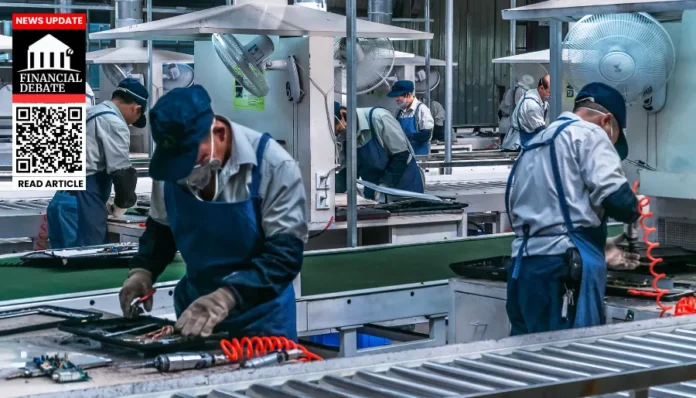- China’s industrial profits fell 4.3% in June and dropped 1.8% for the first half of 2025.
- U.S. tariffs surged, deepening export cost burdens and manufacturing challenges.
- Intense domestic price wars, especially in EVs and autos, are squeezing margins and threatening weaker firms.
China’s Industrial Profits Drop Again in 2025 Amid Trade Tensions and Price Wars
In June 2025, profits for major Chinese industrial firms fell 4.3% compared to June 2024. This decline follows a 9.1% drop in May, making it the second consecutive month of weaker earnings. Persistent factory‑gate deflation, weak domestic demand, and tight global trade conditions are eroding business margins. The data come from the National Bureau of Statistics, highlighting growing financial stress on companies across sectors.
During the first half of 2025, industrial profits dropped 1.8% year‑on‑year, reaching a total of approximately ¥3.44 trillion. While private and foreign firms reported modest gains—+1.7% and +2.5%—state‑owned enterprises saw a sharper fall of 7.6%. Despite a small 1% growth in operating revenue, rising costs and price cuts weighed heavily on profitability across the board.
Government Response and Policy Measures
In response to intensifying price competition in industries like solar panels and electric vehicles, Chinese authorities pledged tougher rules. They aim to curb destructive discounting and enforce market discipline. Measures include regulating auto pricing, solar sector behavior, and launching a vehicle trade‑in stimulus scheme similar to “cash for clunkers” to stabilize demand. Analysts expect such efforts may gradually ease pricing pressure.
Experts warn these reforms may not quickly reverse factory-level deflation, which has persisted for over 30 months in a row. Pushbacks include industrial overcapacity, local governments encouraging production, and limited options for absorbing displaced workers. Without bold structural and demand-side support, recovery may remain slow. Youth unemployment is nearing 14.5%, adding social strain.
Tariff Escalation and Manufacturing Pain
In 2025, the United States significantly escalated tariffs on Chinese imports. Average effective tariff rates soared to 20‑27%, with some estimates putting them at their highest since 1910–1911. Certain categories—especially electronics, autos, and steel goods—faced rates between 25% and 50%, depending on classification. These duties added substantial cost burdens for exporters and disrupted long‑term planning.
Tariff surges began with an initial 10% across-the-board duty in February, followed by further hikes in March and April, and additional penalty rates on select industries. While a 90‑day truce granted some relief starting in May, key electronic components remained heavily taxed at 10–40%, depending on commodity type.
These trade barriers forced manufacturers to navigate complex restrictions and retaliatory measures. The trade escalation undercut export margins and sales volumes, contributing to ongoing profit contractions. Analysts lowered China’s full‑year growth guidance to around 4.4%, citing that tariffs compounded domestic pricing pressures.
Article Link: Russia Cuts Interest Rates as Wartime Economy Slows Down
Automotive Sector’s Price War Deepens
China’s electric vehicle sector has fallen into a damaging price war, threatening weaker manufacturers with collapse. Over 130 brands compete in an overcrowded EV market, yet almost none are profitable. This has reduced investment capacity and innovation spending across the industry.
The government issued a rare warning that no party benefits from excessive discounting. BYD led the cut‑throat pricing, slashing up to 34% on models like the Seagull hatchback. That pushed rival companies such as Geely and Chery to match discounts, dragging prices down to around ¥55,800 (~$7,750) from nearly $10,000—a steep drop undermining margins.
Great Wall Motors’ chairman likened the sector’s state to the Evergrande property collapse, warning that suppliers and car makers are suffering serious losses. He emphasized that depressed pricing is “hammering bottom lines”, warning some startups like Neta and Polestar may face imminent collapse without capital or pricing power.
Sectoral Profit Breakdown 2025
A sector-level review shows the industrial downturn was uneven. Industries such as coal mining saw profits plunge over 50%, chemicals fell nearly 9%, and automotive firms dropped around 12%. In contrast, subsectors like agriculture grew 22–38%, while segments including electronics, heat production, and non-ferrous metals saw gains of up to 10% or more.
SOEs (state‑owned enterprises) suffered steeper declines than private firms. While state-owned profits dropped by 7.6%, private and foreign‑backed companies posted modest increases (around 1.7% and 2.5%, respectively). However, even among private firms, profit growth slowed sharply amid price wars and slower consumer demand.
Article Link: US Threatens 50% Tariffs on Brazil: Economic Shock and Political Backlash
Outlook: Risks, Reforms, and Recovery
Looking forward, many economists expect a gradual improvement in profits if the government effectively curbs destructive price competition and stimulates consumer demand. Programs like trade‑in subsidies could boost domestic auto sales and expand market circulation. However, structural reforms remain critical.
Still, analysts caution that recovery may be slower than in previous cycles due to elevated private-sector exposure and limited buffers. Local governments continue supporting capacity in saturated sectors, and job losses may rise with any downsizing efforts. Observers believe restoring consumer confidence is key to lifting deflation.
Meanwhile, U.S.–China trade talks resumed in Stockholm in late July to extend the tariff truce ahead of an August 12 deadline. While no major breakthrough is expected, negotiators hope to prevent tariffs resetting to over 100%, which could severely disrupt global supply chains.
Conclusion
China’s industrial sector is facing a complex web of challenges: shrinking profitability, severe price competition, and escalating trade barriers. While policy interventions—such as stricter regulation of pricing behavior, consumer stimulus schemes, and trade negotiations—offer hope, recovery may be slow and uneven. Much depends on Beijing’s ability to balance overcapacity reduction, demand stimulus, and China’s role in global trade amid uncertain U.S. relations.
